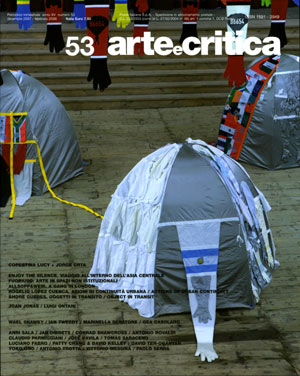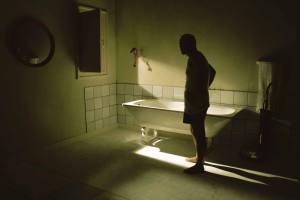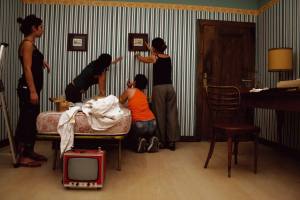L'edicola digitale delle riviste italiane di arte e cultura contemporanea
Arte e Critica Anno 14 Numero 53 dicembre 2007-febbraio 2008
Manuale per viaggiatori
Filipa Ramos
Marinella Senatore

trimestrale di cultura artistica contemporanea

di Maria Antonietta Malleo
56 20 ANNI DI CAREOF / 20 YEARS OF CAREOF
Intervista a / Interview to Mario Gorni e / and Chiara Agnello a cura di / by Katia Anguelova
58 PENSIERI IN CHIAROSCURO X
di Alberto Boatto
60 LUCY + JORGE ORTA. AN EMBLEMATIC VILLAGE
Intervista a cura di / Interview by Daniela Bigi
66 JOAN JONAS / LUIGI ONTANI
71 WAEL SHAWKY. COMPRESENZE, CONFLUENZE E FRIZIONI
di Pier Luigi Tazzi
72 IAN TWEEDY. LA MACCHINA DEL TEMPO
di Marco Scotini
73 FUORIUSO: ARTE IN SPAZI NON ISTITUZIONALI
di Simone Ciglia
74 ALLSOPP&WEIR. A GANG IN LONDON
di / by Ilaria Gianni
76 AL CUORE DELL’EUROPA / IN THE HEART OF EUROPE
Intervista a / Interview to Gabor Littasy a cura di / by Roberto Lambarelli
78 TRA GLI ALBERI, SU UN’ISOLA... IL PORTIKUS
di Eleonora Farina
82 ROGELIO LòPEZ CUENCA. AZIONI DI CONTINUITà URBANA / ACTIONS OF URBAN CONTINUITY
di / by Barbara D’Ambrosio
84 ANDRé GUEDES. OGGETTI IN TRANSITO / OBJECTS IN TRANSIT
Intervista a cura di / Interview by Elisa Del Prete
86 ENJOY THE SILENCE. VIAGGIO ALL’INTERNO DELL’ASIA CENTRALE
di Ilari Valbonesi
88 MANUALE PER I VIAGGIATORI. MARINELLA SENATORE
di / by Filipa Ramos
108 WAITING FOR THE FESTIVAL...
di Elvira Vannini
110 GEA CASOLARO. LA LANTERNA MAGICA / THE MAGIC LANTERN
di / by Olga Gambari
116 IDENTITà IN DIALOGO. VIDEOARTE DALL’ITALIA ALLA WASEDA UNIVERSITY DI TOKYO
di Marco Rizzi
122 A SUD-EST DELL’ARTE. LA PUGLIA
di Francesca de Filippi
126 IL CENOBIO DELL’EDEN
di Alberto Zanchetta
49 ANRI SALA
50 JAN DIBBETS
55 CONRAD SHAWCROSS
57 ANTONIO ROVALDI
90 CLAUDIO PARMIGGIANI
91 JOSé DAVILA
92 TOMÁS SARACENO
93 LUCIANO FABRO
94 PATTY CHANG & DAVID KELLEY
97 LUCA MATTI
98 ALTERAZIONI VIDEO
105 DAVID TER-OGANYAN
112 YOKO ONO
118 GIANFRANCO ZAPPETTINI
121 LUCA MARIA PATELLA
124 PAOLO SERRA
125 ANTONIO TROTTA
128 VITTORIO MESSINA
1985. Trent’anni fa inaugurava il Castello di Rivoli
Roberto Lamabarelli
n. 82 estate 2015
Céline Condorelli
Massimiliano Scuderi
n. 80 primavera 2015
Note su Benoît Maire, Renato Leotta, Rossella Biscotti
n. 79 ottobre-dicembre 2014
Ah, si va a Oriente! Cantiere n.1
Daniela Bigi
n. 78 aprile-giugno 2014
Gli anni settanta a Roma. Uno sgambetto alla storia?
Roberto Lambarelli
n. 77 gennaio-marzo 2014
1993. L’arte, la critica e la storia dell’arte.
Roberto Lambarelli
n. 76 luglio-dicembre 2013

prodotto dal Museo MADRE di Napoli, 2007
HD, colore, st, 45’
Courtesy l’artista

prodotto dal Museo MADRE di Napoli, 2007
HD, colore, st, 45’
Courtesy l’artista

prodotto dal Museo MADRE di Napoli, 2007
HD, colore, st, 45’
Courtesy l’artista
Osservando l’ultimo lavoro di Marinella Senatore, Manuale per i viaggiatori, al MADRE – a cura di Gigiotto Del Vecchio e Stefania Palumbo – emerge come l’arte abbia il potere esclusivo di collegare concetti ed espressioni spesso distanti. Un considerevole numero di opere si rifà ad altrettante opere. Per quanto interessanti, finiscono col ritrovarsi intrappolate nel sistema dell’arte. Altre si allontanano da tale rischio rapportandosi con quella grezza e vivida materia che è l’esistenza. Manuale per i viaggiatori è uno dei momenti in cui la riflessione sulla vita, nei suoi tratti più semplici e al contempo più profondi, si attua perfettamente attraverso l’espressione visiva.
Sviluppato su diversi livelli, questo lungometraggio trova il filo dei propri pensieri in uno specifico dato temporale, la data del 21 giugno 1977, intorno alle otto di sera. Se simbolicamente si allude al solstizio d’estate, il giorno più lungo dell’anno, vi è anche un riferimento alla data di nascita dell’artista; è dunque l’elemento biografico a determinare l’intera narrazione. I personaggi coinvolti, la donna di sevizio, l’acrobata, la donnaccia, l’etnografo, il cuoco, la cantante russa, il bagnino sono persone comuni le cui vite assumono un rilievo inaspettato per la loro esibita normalità. Comunque, è attraverso queste storie quotidiane sviluppate in una commistione di immagini, oggetti e racconti che si comprende come il film non tratti di gente ordinaria ma di temi universali quali solitudine, sogni, amore, desideri, frustrazioni e paure.
Manuale per i viaggiatori è stato concepito come un vero e proprio workshop continuo con più di 300 persone pronte a parteciparvi, sia come artisti che come assistenti al set. L’artista è riuscita a dar vita a un’autentica pratica collettiva, documentata attraverso la registrazione filmica, cui inoltre hanno potuto assistere in tutte le fasi i visitatori che giungevano al museo mentre veniva realizzato il film.
Risulta evidente che l’attività pedagogica di Marinella Senatore, docente all’Università Complutense di Madrid e già all’Università Castilla-La Mancha, ha un forte riscontro nella sua metodologia. In Manuale per i viaggiatori si possono identificare alcuni tratti stilistici tipici della sua pratica; come nelle opere precedenti, anche qui sono riportati sfondo e scenario, attori e staff tecnico, nei rispettivi ruoli. La musica gioca un ruolo importante nel film, spesso crea un dialogo diretto con le immagini. Anche le parole dette hanno una parte rilevante. Descrivendo sempre le azioni in terza persona e usando il tempo al passato, è come se la memoria si fondasse sulla costruzione di varie versioni degli stessi eventi vissuti da outsider, dando così differenti punti di vista della stessa storia.
Stabilendo corrispondenze indirette tra voce, suono e immagine, conducendo lo spettatore attraverso molteplici suggestioni tra ciò che guarda e ciò che sente, l’artista indaga le problematiche semiotiche e filosofiche con un approccio estremamente delicato. Nelle sue opere, il significato è sempre un congegno complesso, profondamente strutturato tra suggestione e intuizione. Un altro elemento chiave del suo lavoro sta nel forte impatto visivo delle descrizioni, che spesso scaturiscono dal modo in cui certi ambienti domestici vengono visti attraverso la fotografia. La luce è uno degli elementi determinanti, diventa materia e definisce spazi, oggetti e situazioni in quanto è usata sia nella sua concretezza visiva che come elemento puro in stretto riferimento alla cultura cinematografica.
Nel film, di fatto, la linea sottile che separa arte, documentario e cinema quasi scompare. È come se l’artista fondesse i linguaggi codificati entro uno spazio difficile da definire, come se essi non avessero ragione di esistere indipendenti l’uno dall’altro.
Rielaborazioni di frammenti di vita passata si mescolano a eventi realmente accaduti (come le immagini dell’Arno in piena), a figure tratte da fumetti, alle rappresentazioni dello staff dell’artista durante le riprese. Tutti insieme compongono una serie di microstorie che costituiscono un manuale per i viaggiatori, quasi un viaggio di vita.
----------------
While seeing Marinella Senatore’s last work, Manuale per i viaggiatori, at MADRE – curated by Gigiotto Del Vecchio e Stefania Palumbo – one realises how art has the unique capacity to unify concepts that are often expressed independently. There is a great quantity of works of art that allude to a whole other amount of works. As interesting as they may be they find themselves locked inside the artistic system. Others move away from this tendency and deal with the raw and vivid material that is existence. Manuale per i viaggiatori is one of these moments in which the reflection on life, simultaneously in its simplest and deepest remarks, is perfectly operated by visual expression.
Developed in many strata, this film finds its train of thought in a specific temporal element, the date of the 21st of June of 1977, at around 8pm. If it symbolically alludes to the summer solstice, the longest day of the year, it also signs the artist’s date of birth, thus a biographical element determines the whole narration. The characters involved, the maid, the tumbler, the woman they call the rat, the ethnographer, the cook, the Russian singer, the old lifeguard, are ordinary people whose lives acquaint an unexpected importance due to its exposed normality. However, it is through these everyday stories developed through an association between images, objects and tales, that one perceives that this film is not about normal people but about the universally of such subjects as loneliness, dreams, love, desires, frustration and fears. Manuale per i viaggiatori was conceived as an authentic tour de force workshop with more than 300 inhabitants that wanted to take part in it, either as artists or as set helpers.
The artist managed to establish a real community practice that was forever documented through the cinematographic recording, but that could also be gradually followed by the visitors that came to the museum while the film was being made. It is clear that the pedagogic activity of Senatore, who has just became a teacher at the Complutense University of Madrid and was already teaching at the Castilla-La Mancha University, has a strong influence in her methodology.
In Manuale per i viaggiatori, one can identify certain elements of style that characterise Senatore’s practice. As in previous works, here she reveals the background, scenery, actors and additional staff in their production duties. Music plays an important part in the film, often establishing a direct dialogue with the images perceived. Spoken words also has an important role. Always describing a third person’s acts and using the past tense, it is almost as memory was built upon the construction of several versions of the same events, experienced by outsiders and thus giving us different sides to the same (hi)story. Establishing indirect correspondences between sound, voice and image, thus leading the viewer through multiple suggestions between what he is seeing and what he is hearing, the artist explores semiotic and philosophical concerns with an extremely delicate approach. Meaning, in her works, is always a complicate construction that is deeply structured between suggestion and intuition. Another important element in Senatore’s work is the strong visual impact of her depictions, often given by the way in which certain domestic environments are photographically represented.
Light is one of the most important elements, it becomes matter and it defines places, objects and situations, being used both as a visual concreteness and as a pure element with straight associations with cinematographic culture.
In fact, the thin line that separates art, documentary and cinema almost disappears through the film. It seems like the artist merges these classifications into a limit of impossible definition and they find no reason to exist independently of each other.
Certain recreations of a moment from the past mix themselves with veridical documents of the past (like the images of the Arno flood), with images taken from comic books and with depictions of the artist’s staff during the shootings. Together, they compose an array of fragmented tales that define a manual for travellers, almost a life journey.


